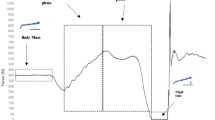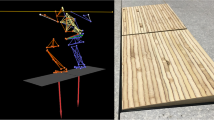Abstract
This study investigated the test-retest reliability and validity of the isokinetic and gravity/inertia modes of the Lido LiftTM and the Progressive Lifting Capacity II test (PLC II). Maximum lifting capacity tests were performed in the isokinetic and gravity/inertia modes on the Lido Lift and with the PLC II with 29 healthy male subjects. Pearson product-moment correlations were calculated to determine the test-retest reliabilities and to compare PLC II test values with isokinetic and gravity/inertia test values. The correlations for the isokinetic, gravity inertia, and the PLC II werer=.90, .82, and .91, respectively. The correlations between the isokinetic and gravity/inertia tests and the PLC II werer=.64 and .74 during the test andr=.72 and .81 during the retest. The results of this study support the reliability of both Lido LiftTM tests and of the PLC II, and the validity of the isokinetic and gravity/inertia tests when compared to the PLC II.
Similar content being viewed by others
References
Bigos S, Spengler D, Martin N, Zeh J, Fisher L, Nachemson A, Wang M. Back injuries in industry: a restrospective study II. Injury factors.Spine 1986; 11(3): 246–251.
Chaffin DB. Manual materials handling: The cause of over-exertion injury and illness in industry.J Environ Pathol Toxicol 1979; 2(5): 31–66.
Troup J, Martin J, Lloyd D. Back pain in industry: A prospective study.Spine 1981; 6(1): 61–69.
Chaffin D, Herrin G, Keyserling W. Preemployment strength testing.J Occup Med 1978; 20(6): 403–408.
Kroemer K. An isoinertial technique to assess individual lifting capability.Hum Factors 1983; 25(2): 493–506.
Menon K, Freivalds A. Repeatability of dynamic strength tests.Proc Hum Factors Soc 1985; 29(1): 517–520.
Kroemer K. Human strength terminology, measurement, and interpretation of data.Hum Factors 1970; 12: 297–313.
Karwowski W, Yates J. Reliability of the psychophysical approach to manual lifting of liquids by females.Ergonomics 1986; 29: 237–248.
Mital A. The psychophysical approach in manual lifting—a verification study.Hum Factors 1983; 25(5): 485–491.
Mayer T, Barnes D, Kishino N, Nichols G, Gatchel R, Mayer H, Mooney V. Progressive isoinertial lifting evaluation: I. A standardized protocol and normative database.Spine 1988; 13(9): 993–997.
Matheson L, Mooney V, Jarvis G, Caiozzo V, Lichter R, DeBerry C, Pottinger J, Levin K, Backlund K. Progressive lifting capacity with masked weights: Reliability study. Presented at the International Society for the Study of the Lumbar Spine, Boston, Massachusetts, June 1990.
Thistle H, Hislop H, Moffroid M, Lowman E. Isokinetic contraction. A new concept of resistive exercise.Arch Phys Med 1967; 48: 279–282.
Aitkens S, Lord J, Bernauer E, McCrory M. Analysis of the validity of the Lido Digital Isokinetic System (Abstract).Phys Ther 1987; 67(5): 757.
Burdett R, Van Swearingen J. Reliability of isokinetic muscle endurance tests.J Orthop Sports Phys Ther 1987; 8(10): 484–488.
Langrana N, Lee C, Alexander H, Mayott C. Quantitative assessment of back strength using isokinetic testing.Spine 1984; 9(3): 287–290.
McCrory M, Aitkens S, Avery C, Bernauer E. Reliability and validity of the Lido Active Isokinet Rehabilitation System.Med Sci Sports Exerc 1989; 21(2): S52.
Rose S, Delitto A, Crandell C. Reliability of isokinetic trunk muscle performance (Abstract).Phys Ther 1988; 68(5): 824.
Smith S, Mayer T, Gatchel R, Becker T. Quantification of lumbar function: Part 1. Isometric and multispeed isokinetic trunk strength measures in sagittal and axial planes in normal subjects.Spine 1985; 10(8): 757–764.
Frykman P, Harmon E, Vogel J. Using a new dynamometer to compare three lift styles.Med Sci Sports Exerc 1988; 20(2): 87.
Porterfield J, Mostardi R, King S, Ariki P, Moats E, No D. Simulated lift testing using computerized isokinetics.Spine 1987; 12(7): 683–687.
Rothstein J, Lamb R, Mayhew T. Clinical uses of isokinetic measurements: Critical issues.Phys Ther 1987; 67: 1840–1844.
Timm K. Isokinetic lifting simulation: A normative data study.J Orthop Sports Phys Ther 1988; 10(5): 156–166.
Kishino N, Mayer T, Gatchel R, Parrish M, Anderson C, Gustin L, Mooney V. Quantification of lumbar function: Part 4. Isometric and isokinetic lifting simulation in normal subjects and low back dysfunction patients.Spine 1985; 10(10): 921–927.
Feiring D, Ellenbecker T, Derscheid G. Test-retest reliability of the Biodex Isokinetic Dynamometer.J Orthop Sports Phys Ther 1990; 11(7): 298–300.
Lord J, Aitkens S, McCrory M, Bernauer E. Reliability of the Lido Digital Isokinetic System for the measurement of muscular strength (Abstract).Phys Ther 1987; 67(5): 757.
Tredinnick T, Duncan P. Reliability of measurements of concentric and eccentric isokinetic loading.Phys Ther 1988; 68(5): 656–659.
Pytel J, Kamon E. Dynamic strength tests as a predictor for maximal acceptable lifting.Ergonomics 1981; 24: 663–672.
Kim J, Marras W. Quantitative trunk muscle electromyography during lifting at different speeds.Int J Ind Ergonomics 1987; 1: 219–229.
Garg A, Mital A, Asfour S. A comparison of isometric strength and dynamic lifting capacity.Ergonomics 1980; 23: 13–27.
Author information
Authors and Affiliations
Rights and permissions
About this article
Cite this article
Alpert, J., Matheson, L., Beam, W. et al. The reliability and validity of two new tests of maximum lifting capacity. J Occup Rehab 1, 13–29 (1991). https://doi.org/10.1007/BF01073277
Issue Date:
DOI: https://doi.org/10.1007/BF01073277




